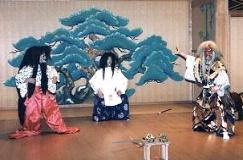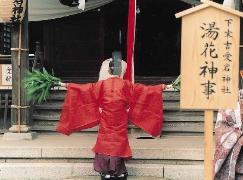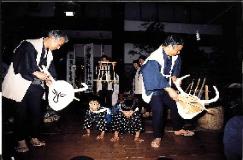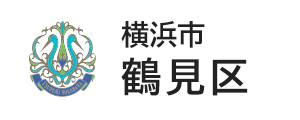- Yokohama-shi Top Page
- Tsurumi Ward Top Page
- Introduction of the ward
- Overview of Tsurumi Ward
- History of Tsurumi Ward
- 5th: Traditional performing arts of Tsurumi
- 5th: Traditional performing arts of Tsurumi (Part 2)
Here's the text.
5th: Traditional performing arts of Tsurumi (Part 2)
Last Updated November 7, 2024

Jindai Kagura is also known as "Iwato Kagura" or "Sato Kagura", and is a masked silent drama mainly performed based on Japanese mythology. Tsurumi has Market Jindai Kagura and Koyasu Jindai Kagura.
Market Jindai Kagura was handed down to the Kumano Shrine Miyaji family in Tsurumi-ku Market, Yokohama City along the old Tokaido, and it seems that it had been performed before that because ancient documents related to Kagura of 1690 remain. . It is now handed down to the Hie-jinja Shrine in Yako.
The musical instruments used for Kagura include music such as large drums, large beats, flutes (nokan and Shinobue), gongs, and masks (hime, old man, demon, etc.) according to the role of each performance. It is mainly performed based on the myths of "Kojiki" and "Nihonshoki", but it is influenced by Noh, Kyogen, Kabuki, etc., and also takes into account artistry and entertainment.
Market Jindai Kagura, which was handed down by the Shinto priest's market town Kumano Shrine and Yamucho Hie Shrine Miyaji Hagiwara family, is currently active mainly at shrines in Tsurumi Ward and Kawasaki, while practicing once or twice a week at the shrine office of Hie-jinja Shrine. The main songs are "Ameno Ukihashi", "Yomotsu Shikome", "Sumie Okami", "Amano Iwato", "Yakumo Shinei" and "Yukenbunkai".
At Sugiyama Shrine in Kishiya, Koyasu Kagura, which was handed down to Koyasu, Kanagawa-ku until the early Showa period, was performed. In addition, dedication kagura was performed at festivals of shrines in each area of the ward.

Yuka Shinto is also called Yudate (Yudachi / Yudate), and is a ritual of evil that sprinkles boiled hot water. In addition, it has been practiced since ancient times as a ritual to pray for no illness, safety at home, and rich harvest.
On the day of the festival, four green bamboos are set up in front of the shrine, a cauldron is set up there, the hot water boiled by the priest is included in Kumasasa, sprinkled toward the god of the festival, and then purify the worshipers. Sprinkling the boiled water in the same way and purify it. When this hot water is applied, it is said that "I will not be sick for one year" and "I will fulfill my wish", and it is still widely worshiped.
Yuka Shinto is a purifying event, but it is said that it was the original form of fortune-telling and trusting by Yudate, and it was a simple and universal ritual that asked the will of God.
In Tsurumi Ward, it has been held at Yahata Shrine in Uemiya and Tsurumi, and at Atago Shrine in Shimosueyoshi, but now it is held only on the first Sunday of August every year at Atago Shrine in Shimosueyoshi.

In the section of Tsurumi Village in the “New Edition Musashi Country Fudoki” compiled at the end of the Edo period, Sugiyama Daimyojin (Tsurumi Shrine) was described as “Myojin, where farmers and others sing every year on the evening of New Year's Day every year at this shrine since ancient times. There is a song called the festival of the Kanto region, especially the ancient style of the Kanto region. This rice festival song is "Kamihogi Uta" sung at the Tsurumi Field Festival.
The three-tiered Shintoka, which starts with "Neire Nere and I'm in front of you ...", is literaryly excellent, and various things such as folklore, religion, customs, and overview of farming in this area at the time. It is said to be a valuable literature that contains the contents.
Japanese, who have been mainly engaged in rice farming since ancient times, welcome the god of the field from the mountains in the spring, hold a celebration event to pray for the harvest of rice cultivation in that year, and thank the harvest in autumn and send the god of the field to the mountains. We have been holding a festival event to send. The Tsurumi Field Festival is a spring celebration event that prays for the harvest of the five grains of the year. The rice field festival is also said to be playing in the field.
On the evening of the New Year's Day, a series of rice-planting, rice-planting, rice-planting, rice-planting, rice-planting, rice-planting, and other farming tools such as scythes and hoes are used in a rice field that resembles a rice pot and ridge. A rice paddle made with bamboo shoots and bamboo shoots that resemble rice fields.
At the Tsurumi no Ta Festival, a traditional event that has been handed down to the land of Tsurumi since the Kamakura period about 700 years ago was interrupted in 1875 (Meiji 5) after the Meiji Restoration, but the old family The old documents and the articles related to the Kotobuki Festival were used in articles such as the "Chigusa" of the former Miyaji Kurokawa Sozo of Tsurumi Shrine. In order to revive precious traditional culture, the Tsurumi History Society and local volunteers went to Mishima Taisha Shrine in Shizuoka Prefecture, Kitano Shrine in Tokumaru, Itabashi-ku, Tokyo, and Suwa-jinja Shrine in Suwa-jinja Shrine in Akatsuka, Itabashi-ku. It was revived in 1987 after conducting research and research and deciphering Shinto songs. Currently, it is held on the grounds of Tsurumi Shrine every year on April 29, Green Day. Child roles such as Saotome and cows also appear, creating a smile and familiarity. On the day, local Neighborhood Associations and volunteer groups also set up mock shops for yakisoba and cotton candy to excite the rice field festival.
Inquiries to this page
Tsurumi Ward General Affairs Department Ward Administration Promotion Division
Telephone: 045-510-1680
Telephone: 045-510-1680
Fax: 045-510-1891
Email address: tr-kusei@city.yokohama.lg.jp
Page ID: 550-857-670













